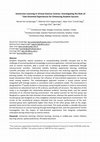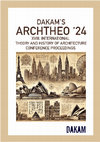Conference Presentations by Beril Bas

WEI International Academic Conference in Istanbul, Turkiye, August 06-08, 2024, 2024
Students frequently require assistance in comprehending scientific concepts due to the challenge ... more Students frequently require assistance in comprehending scientific concepts due to the challenge of connecting abstract knowledge to practical application. Informal learning settings, such as science museums, play a crucial role in enhancing students' experiences through extracurricular activities. Interactive exhibits facilitate experiential learning, solidifying scientific principles and converting theoretical constructs into enduring cognitive schemas. Furthermore, the integration of advanced virtual educational technologies offers immersive learning models. This study introduces an innovative methodological framework within a VRbased educational milieu to discover the influence of task-oriented experiences on learning levels among students. The methodological approach involves a virtual science centre integrated with teenage avatars in accordance with a predictive model. The environment is designated for 7 th-grade students in two groups comprising 80 students in total to interactively experience an educational tool on life sciences, specifically cell structure. The objective of this study is to investigate the relationship between students' learning levels, and the spatial attributes of an informal learning environment. The spatial scenario for the first group was designed as a game-like task-oriented virtual experience, whereas the spatial scenario for the second group was designed as a free navigation-oriented virtual experience environment. The results of the correlational analysis indicated that the success performances of the taskoriented group were significantly higher than those of the other group, both at the singlequestion level and at the overall success score level. This study provides a valuable discussion for the literature on science learning through technological tools, with the potential for further investigation into the impact of task-oriented experiences that integrate competition motivation during school trips to science centres.
Conference Paper by Beril Bas

ARCHTHEO ’24 / XVIII. INTERNATIONAL THEORY AND HISTORY OF ARCHITECTURE CONFERENCE, 2024
Wayfinding should ensure that individuals do not waste time or feel anxious while reaching their ... more Wayfinding should ensure that individuals do not waste time or feel anxious while reaching their specific destinations. Investigating this process in school buildings is crucial due to the necessity of reaching classrooms promptly without causing stress. This study was conducted as the term project of the master’s degree course ARCH 503 Theory of Architecture, examining wayfinding in the Faculty of Architecture and Design at a university building, and investigating how alternative routes and architectural design affect reaching specific spaces. The methodological approach adopted in the study is based on a task-oriented wayfinding study, which involves participants finding designated spaces as a directed task, hence behaviour maps were used. In this way, wayfinding behaviour within the faculty building was examined in depth based on behaviour maps and observations. One of the main objectives of this study is to evaluate wayfinding within both horizontal and vertical circulation in the building. Thus, elevator usage was restricted during the research process. Reasons for this include the availability of floor plans inside the elevators and clearer accessibility to floors via elevator buttons. Therefore, the most common and preferred route was to go down the stairs from the main entrance staircase and then use the main staircase to reach the relevant floors. Additionally, using the fire exit could have caused confusion during wayfinding and negatively impacted the process. This study was conducted with the participation of twenty students who were unfamiliar with the faculty building and were expected to find the spaces sequentially, as instructed by the researchers. The students’ unfamiliarity with the faculty building and their equal levels of knowledge helped the research in achieving more reliable results. Additionally, sequentially finding spaces was aimed at reducing the complexity or diversity within behaviour maps. The navigation time to find the spaces was recorded, and the route of each participant was documented as a behaviour map. All the twenty routes were overlapped onto a single map, demonstrating the hesitation points with the reasons observed during wayfinding. In addition, the data obtained from the behaviour maps were supported by the responses to questions posed to participants at the end of the study. As a result of this study, the routes followed, the more preferred route, the duration of each navigation, the route distances, the total time of all the completed routes, the space, which was the most difficult and easiest to find, and the reasons of the challenges were revealed. The findings demonstrate that during wayfinding, the signs, colours, sizes, the impact of crowding within the space, and lighting play significant roles. Additionally, as the wayfinding study also involves vertical navigation within the building, it is understood that the ergonomic design of the stairs significantly affects wayfinding. In conclusion, the study highlighted the importance of considering architectural design elements such as signage and spatial layout in enhancing wayfinding efficiency and user experience within educational environments. These insights contribute to broader discussions on optimizing navigational strategies in complex building settings, showing that this study provided insight into the impact of plan configuration and signage on wayfinding behaviour in higher education buildings.








Uploads
Conference Presentations by Beril Bas
Conference Paper by Beril Bas